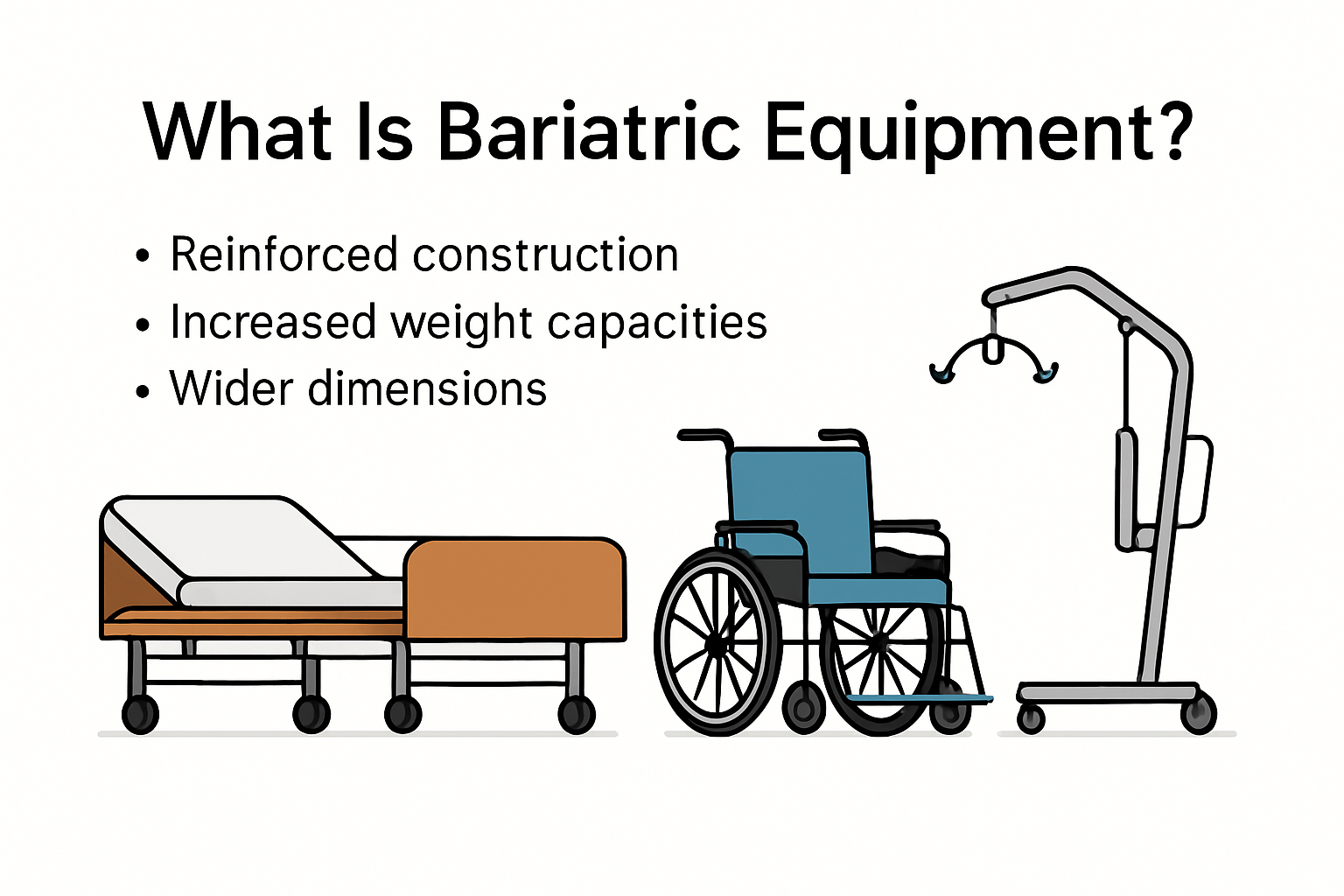

Bariatric equipment is changing the experience for patients with obesity. Some bariatric beds can safely support up to 1000 pounds, more than double what standard hospital beds can handle. Think that means bigger is all that matters? Actually, the real breakthrough is in the details. It is the careful design choices and personalized support that often make the biggest difference in safety, comfort, and dignity for patients and caregivers alike.
View our top rated Bariatric Beds
View our top rated Bariatric Mattresses
View our top rated Bariatric Patient Lift
| Takeaway | Explanation |
|---|---|
| Bariatric equipment is essential for patient care | Specialized medical devices are designed to support patients with obesity, improving safety and comfort in healthcare settings. |
| Key features include enhanced weight capacity and durability | Bariatric equipment is constructed with reinforced structures, wider dimensions, and is designed to support patients weighing 500 pounds or more, ensuring safety during use. |
| Selecting the right equipment requires comprehensive evaluation | Factors like weight capacity, patient morphology, and facility considerations are crucial in choosing the appropriate bariatric supplies to enhance patient care. |
| Collaborative assessments improve equipment selection | Engaging healthcare professionals, caregivers, and patients in the selection process leads to better outcomes and ensures that specific needs are met effectively. |
| Continuous monitoring and evaluation are necessary | Regular assessments of patient needs and equipment effectiveness help maintain safety and comfort, facilitating adjustments to care as conditions change. |
Bariatric equipment represents a specialized category of medical devices engineered to support patients with obesity, providing critical support and enhanced safety for individuals requiring more robust healthcare solutions. These medical tools go beyond standard equipment by incorporating reinforced structures, expanded dimensions, and increased weight capacities designed to accommodate patients with unique physical needs.

Bariatric equipment is specifically designed to support individuals with higher body weights, addressing the complex medical requirements of patients who exceed standard medical device weight limits. Research from the National Institutes of Health indicates that these specialized devices are crucial in providing safe, comfortable, and dignified medical care for patients with obesity.
Typical bariatric equipment includes heavy-duty medical devices such as hospital beds, wheelchairs, mobility aids, patient lifts, and specialized medical chairs. These items are engineered with reinforced frames, wider seats, and higher weight capacities compared to standard medical equipment. The primary goal is to ensure patient safety, comfort, and proper medical support while preventing potential injuries to both patients and healthcare providers.
To help clarify the differences between standard and bariatric medical equipment, the following table summarizes key distinguishing features:
| Feature | Standard Medical Equipment | Bariatric Medical Equipment |
|---|---|---|
| Typical Weight Capacity | Up to 350 lbs | 500 - 1000+ lbs |
| Frame Construction | Standard steel/aluminum | Reinforced, industrial-grade steel |
| Seat/Bed Width | Narrower (16-22") | Wider (22-48" or more) |
| Mobility/Transfer Features | Basic | Specialized wheels/support mechanisms |
| Intended Patient Population | General patient use | Patients with obesity/higher weight needs |
The most significant distinguishing features of bariatric equipment involve structural integrity and enhanced weight support. According to medical research publications, these devices typically offer:
Healthcare facilities and medical professionals recognize that standard medical equipment often fails to meet the complex needs of patients with obesity. By implementing specialized bariatric equipment, medical teams can significantly improve patient care, reduce potential injury risks, and create more inclusive medical environments.
The development of bariatric equipment represents a critical advancement in patient-centered healthcare, acknowledging that medical support must adapt to diverse patient body types. Clinical studies demonstrate that proper bariatric equipment can reduce complications, improve patient comfort, and enhance overall medical treatment outcomes.
Understanding what is bariatric equipment goes beyond simple measurements and weight limits. It encompasses a comprehensive approach to patient care that prioritizes safety, dignity, and medical effectiveness for individuals with diverse physical needs. As medical technology continues to evolve, bariatric equipment will undoubtedly play an increasingly important role in providing comprehensive, compassionate healthcare solutions.
Bariatric equipment encompasses a diverse range of medical devices specifically engineered to provide comprehensive support for patients with higher body weights. These specialized tools address unique medical and mobility challenges, ensuring patient safety, comfort, and dignity across various healthcare settings.
Research from medical equipment specialists reveals multiple critical categories of bariatric equipment designed to meet specific patient needs. Bariatric wheelchairs represent a fundamental solution, constructed with reinforced frames and wider seats to accommodate patients requiring enhanced mobility support. These wheelchairs typically feature:

Clinical research highlights the importance of specialized bariatric beds and patient transfer equipment. Bariatric hospital beds are engineered to provide safe, comfortable sleeping and medical care surfaces for patients with higher body weights. These beds offer unique features such as:
Bariatric commodes and personal care equipment represent another crucial category of specialized medical devices. Medical equipment experts emphasize the importance of designing toileting and personal hygiene solutions that prioritize patient dignity and safety. These specialized devices typically include:
To demonstrate the diversity of bariatric equipment types and the distinct benefits they provide, the table below summarizes the main categories and their key features.
| Equipment Type | Key Features & Benefits |
|---|---|
| Bariatric Wheelchairs | Reinforced frames, wider seats, higher capacities, enhanced maneuverability |
| Bariatric Hospital Beds | 1000 lb+ capacity, adjustable positions, reinforced frames, pressure relief support |
| Patient Lifts | Secure transfer, caregiver safety, reduced injury risk |
| Bariatric Commodes | Wider seating, higher weight support, stability for hygiene and toileting |
| Shower Chairs | Non-slip, reinforced materials, increased comfort and safety |
The development of bariatric equipment represents a significant advancement in patient-centered healthcare. By creating devices that accommodate diverse body types, medical professionals can improve patient outcomes, reduce potential injuries, and enhance overall quality of care. These specialized tools go beyond simple weight accommodation, representing a comprehensive approach to medical support that recognizes individual patient needs.
As medical technology continues to evolve, bariatric equipment will likely become even more sophisticated, offering increasingly personalized solutions for patients requiring specialized medical support. The ongoing commitment to developing these critical medical devices demonstrates the healthcare industry’s dedication to providing comprehensive, compassionate care for all patients.
Selecting appropriate bariatric beds, mattresses, and patient lifts requires careful consideration of multiple factors to ensure patient safety, comfort, and optimal medical care. Healthcare professionals and caregivers must evaluate specialized equipment that addresses the unique needs of patients with higher body weights.
Research from nursing experts emphasizes the critical importance of choosing bariatric beds with specific features. Bariatric bed selection involves evaluating several key components:
When selecting mattresses, medical safety guidelines recommend prioritizing pressure distribution and compatibility with the bed frame. Specialized bariatric mattresses must address unique challenges such as:
Clinical research highlights the critical importance of selecting appropriate patient lift systems for bariatric care. Ceiling-mounted lift systems offer several significant advantages:
The selection process for bariatric patient handling equipment goes beyond simple measurements. Healthcare providers must consider individual patient needs, medical conditions, and potential mobility challenges. Proper equipment selection can significantly improve patient outcomes, reduce medical complications, and enhance overall care quality.
Key considerations include assessing the patient’s specific weight, mobility limitations, medical conditions, and potential future care requirements. Some bariatric beds offer advanced features like programmable positioning, integrated side rails, and customizable support mechanisms that can adapt to changing patient needs.
Caregivers should work closely with medical professionals to conduct comprehensive assessments. This collaborative approach ensures that selected equipment provides maximum safety, comfort, and support. Periodic equipment evaluation remains crucial, as patient needs may change over time.
The investment in high-quality bariatric beds, mattresses, and lift systems represents a commitment to comprehensive patient care. By prioritizing specialized equipment that addresses unique patient requirements, healthcare providers can create safer, more dignified medical environments that support patients of all body types.
Selecting appropriate bariatric medical supplies requires a comprehensive approach that goes beyond basic weight considerations. Healthcare professionals and caregivers must evaluate multiple critical factors to ensure patient safety, comfort, and optimal medical support.
Medical equipment experts emphasize the paramount importance of weight capacity and structural integrity when choosing bariatric supplies. Equipment selection involves a detailed assessment of several crucial elements:
Specialized research reveals that patient morphology extends far beyond simple weight measurements. Comprehensive equipment selection requires understanding:
Technical infrastructure assessments highlight the critical importance of evaluating facility environments when selecting bariatric supplies. Key environmental factors include:
To assist with the evaluation process, the table below organizes key selection factors for bariatric medical supplies, grouped by critical area.
| Area | Key Selection Factors & Considerations |
|---|---|
| Weight & Structure | Match capacity (25-50% over patient), reinforced components, safety locks |
| Patient Morphology & Needs | Body shape, mobility limits, comorbidities, personalized support |
| Facility & Environment | Door/room size, mobility requirements, floor strength, maneuverability |
The selection process demands a holistic approach that integrates patient needs, medical requirements, and environmental constraints. Healthcare providers must collaborate closely with patients, medical teams, and equipment specialists to develop comprehensive supply solutions.
Advanced assessment techniques now incorporate digital measurement technologies, 3D body scanning, and predictive modeling to enhance equipment selection accuracy. These innovative approaches allow for more precise matching of patient needs with appropriate medical supplies.
Beyond technical specifications, the selection process must prioritize patient dignity, comfort, and psychological well-being. Equipment that supports patient independence and reduces potential embarrassment can significantly improve overall treatment outcomes and patient engagement.
Ultimately, selecting bariatric supplies represents a complex, multifaceted decision-making process. By approaching equipment selection with comprehensive, patient-centered strategies, healthcare providers can create safer, more supportive medical environments that address the unique needs of patients with diverse body types and medical requirements.
Bariatric equipment refers to specialized medical devices designed to support patients with obesity, accommodating their unique weight and mobility needs. This includes items like hospital beds, wheelchairs, patient lifts, and personal care solutions that offer enhanced safety and comfort.
Bariatric equipment differs from standard medical equipment by having a higher weight capacity (500 to 1000 pounds), reinforced construction, and wider dimensions to provide comfortable support for patients with obesity, thus ensuring their safety and dignity.
Available types of bariatric equipment include bariatric wheelchairs, hospital beds, patient lifts, commodes, and shower chairs, each designed to assist patients with higher body weights in various aspects of care, mobility, and hygiene.
To choose the right bariatric supplies, assess key factors such as weight capacity, patient morphology, individual needs, and facility considerations. Collaborating with healthcare professionals can help ensure that the selected equipment meets the specific requirements of the patient.
Finding the right bariatric equipment can feel overwhelming, especially when safety, comfort, and dignity are on the line. As you learned in our guide, not every hospital bed, mattress, or patient lift offers the structural strength and thoughtful design needed for patients with higher weight needs. Gaps in proper support can lead to discomfort or even risk of injury for your loved ones and caregivers.

At MedShop Direct, you can find specialized solutions like bariatric hospital beds, alternating pressure mattresses, and reliable patient lifts that match the standards highlighted in our article. Every product is chosen for its proven durability, broad capacity, and comfort features demanded in real care environments. See what others say about our service and get trustworthy advice on your purchases. Visit MedShop Direct for a simple, transparent, and secure shopping experience. Shop now for the equipment that delivers safer and more comfortable care at home or in your facility.
placeholder